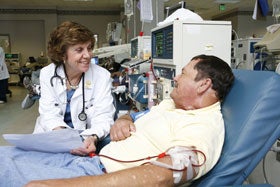News - When Should I Start Dialysis?

By Leslie Spry MD FACP FASN
The decision to start dialysis is a very personal one that a patient should make together with his nephrologist. It may involve others, such as your family, your minister, or your friends, but the final decision is made with input from you and your physician. It is not based on any particular laboratory test or any specific number. It is based on whether your symptoms are consistent with advanced chronic kidney disease (CKD) and whether dialysis has the potential to relieve those symptoms.
Chronic kidney disease and treatment
There are five Stages of CKD, with the most advanced being Stage 5, with an estimated glomerular filtration rate (eGFR) of less than 15. It is generally patients with Stage 5 CKD that are considered candidates to start dialysis therapy or be considered for kidney transplantation. Once dialysis or transplantation is felt to be necessary, this is called End Stage Renal Disease (ESRD). If your eGFR is less than 20, you can be evaluated and placed on the waiting list for a kidney transplant. A transplant center will put you on the list if they deem you eligible for transplantation. Transplantation can be performed prior to the need for dialysis, if kidney failure is progressing slowly enough so that your symptoms can be controlled with diet and medication.
Know your options for dialysis therapy
You should be educated on the choices for dialysis. There are two general forms of dialysis therapy. Hemodialysis or blood dialysis can be performed in a center where you come for dialysis three times weekly and dialysis treatments are generally about four hours long. Alternatively, you can be taught to do hemodialysis at home. This is known as home hemodialysis and this may take 3 or 4 weeks to learn. Home hemodialysis is generally done five or six days per week for shorter amounts of time. Home hemodialysis can be done in short daily sessions, overnight “nocturnal” sessions or every other day longer sessions. Hemodialysis requires that you have a fistula created as a blood access in your arm. This must be created several months before you start dialysis therapy.
The second form of dialysis is peritoneal dialysis (PD). This is another form of home dialysis therapy that is performed by surgically inserting a tube or catheter into your abdomen and then learning how to flow fluid into your abdomen several times per day. Learning how to do PD generally can be done in about one week. Peritoneal dialysis is done 7 days per week and can be done during the day, whereby fluid is drained and then replaced four or five times daily. Each “exchange” takes about 30 minutes. Alternatively, you can be connected to a cycler dialysis machine at night and the machine will then do the exchanges over about 9 hours. This is known as nocturnal PD or continuous cycled peritoneal dialysis (CCPD). You would then travel to the dialysis clinic once per month to be evaluated.
What if I don’t want dialysis or transplant treatment?
It is always your choice as to whether you even consider dialysis therapy. Some people decide that dialysis therapy is not for them and they choose to forgo dialysis therapy. They would choose to live as long as they can, as well as they can. Many older individuals may not benefit from dialysis therapy, if their underlying health and physical status is very poor. Dialysis is an option. You may choose to do dialysis therapy as a trial. If you don’t like dialysis, you can stop. Your nephrologist can continue to care for you off of dialysis therapy.
Reasons to start dialysis therapy
Reasons why you start dialysis therapy are varied. The most common reason to start dialysis therapy is because you are retaining fluid that is causing edema or you are experiencing difficulty with fluid accumulation in your lungs. If this cannot be treated with medication, then dialysis may be the only option. If you develop fluid around your heart or inflammation around the heart (known as pericarditis) then dialysis may also be needed. Weight loss with advanced Stage 5 CKD is a very poor prognostic sign and may indicate the need for dialysis.
Symptoms of advanced chronic kidney disease
Common symptoms of advanced Stage 5 CKD are nausea, vomiting (especially in the early mornings), itching, loss of energy, and loss of appetite. Many of these symptoms can be relieved with dialysis therapy. The accumulation of toxic wastes in your blood such as potassium and acid can sometimes require the initiation of dialysis therapy. The nephrologist and you must review all of your symptoms, know your underlying medical status and then discuss with you the things that dialysis may help and the things that may be complicated by starting dialysis therapy. Two major areas of concern are your ability to travel and your social support at home. Those patients who have little social and family support at home do not do well on dialysis therapy. If you are unable to easily travel to a dialysis center, home dialysis may be an easier consideration for some patients.
Medicare and dialysis
Patients frequently have many financial questions about dialysis therapy. Medicare pays for 80 percent of dialysis therapy in those individuals who are eligible for Medicare or for Social Security Disability. If you are not currently on Medicare, there may be a three month waiting period to be eligible for Medicare coverage. If you start home dialysis therapy, either peritoneal dialysis or home hemodialysis, Medicare coverage can be immediate. More information is available at the Medicare web site. Pre-dialysis education is also covered under Medicare. You should discuss this with your nephrologist. For more information, visit the dialysis section of our A to Z Health Guide here.